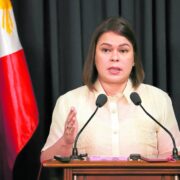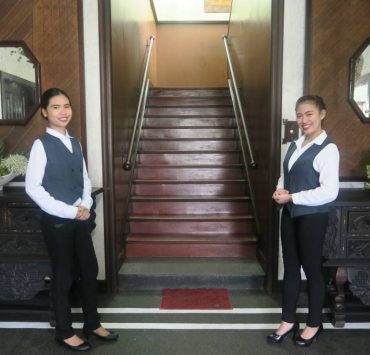Lessons for PH journos: Gone are days of ‘cowboy reporting’
The Maguindanao massacre in 2009 that left 59 people dead —32 of them journalists and media workers—brought to the fore the deadly risks that Philippine media face in the line of duty.
The unprecedented attack—the deadliest against journalists in history—also prompted media outlets and organizations to rethink outdated norms on reporter safety, according to National Union of Journalists in the Philippines (NUJP) chair Jonathan de Santos.Gone are the days, for example, of “cowboy reporting,” De Santos said. “Before, (people) were just willing to take risks—reporters would even go to coverages without coordinating with [their editors], as long as they get the story. Now, there is greater awareness of the need for basic safety protocols.”
Not worth dying for
Over the years, the NUJP and the Center for Media Freedom and Responsibility (CMFR) have been leading efforts to better educate media about safety protocols, especially during dangerous assignments. Both organizations have helped make this practice more mainstream by regularly conducting training programs, risk documentation and campaigns to ensure the safety of media people.
These efforts are particularly helpful since the Philippines has been consistently ranked among the deadliest countries in the world for journalists, said CMFR executive director Melinda Quintos de Jesus. Since the fall of the Marcos dictatorship in 1986, almost 200 journalists have been killed in the line of duty.
But “the idea is that no story is worth dying for,” De Santos stressed.
Years before the Maguindanao massacre, the NUJP has already been advocating for media safety. In 2005, it set up a media safety office in partnership with the International Federation of Journalists (IFJ). The move, according to a briefer on the safety office, was prompted in part by the IFJ’s fact-finding mission that year which found that a “culture of violence and impunity—both tolerated and exacerbated by the Philippine government—[had] contributed to the murders of journalists since 1986.”“A safety office, it deemed, is needed to deal with the attacks and implement safety training for journalists, as well as promote alternative ways of dealing with complaints against media,” it said.
Safety assessmentAccording to De Santos, big news organizations like ABS-CBN, GMA 7 and the Inquirer tend to have such protocols in place. “But our assumption is that small newsrooms in the provinces do not have access or the capability to conduct such things … so we make an effort to reach out to them.”
He said that a typical NUJP safety training, for example, would cover broad basics, including encouraging reporters and newsroom managers to craft sound safety assessment and coverage plans regarding staff deployment.
The plans should clearly outline all anticipated coverage risks, with reporters aware if they are covering a high-risk event or meeting with a person who may be under surveillance. There should also be different backup plans in case things go awry, particularly in assignments involving armed conflicts, disasters and outbreaks. Another recommendation from the NUJP is to plan ahead by researching the area: understanding the locals’ customs and traditions; touching base with local journalist groups; knowing who the main figures are and familiarizing one’s self with the location (exits, border crossings, safe spaces and checkpoints).
Right gear
During deployment, journalists are advised to be mindful of their surroundings and check if they are being followed. If possible, they must always have a trusted companion and coordinate all their movements with their managers as often as possible.
In coverages that involve disasters or health outbreaks, the NUJP advises journalists to always pack safety gear like bulletproof vests, helmets, identification cards and gas masks.
De Santos said that the 2013 coverage of Supertyphoon “Yolanda” (international name: Haiyan) as well as the COVID-19 pandemic showed that working in tandem or as a group would help ensure the safety of reporters.
While this may not have been true for victims of the Maguindanao massacre, he pointed out that it was always advisable to have more people aware of your needs and be able to respond quickly.
“Gone are the days of ‘bara-bara’ (impulsive) coverage when you just go when you feel like it and tag along with whomever,” De Santos said. “Basically, there is now an emphasis on coordination.”
He admitted, however, that much still needs to be done to make such protocols more mainstream. For one, there have been few trainings so far on what journalists should do in case of crossfires and shootouts. Digital hygieneThe NUJP, he said, was also trying to emphasize ethical reporting again. “Whether we like to admit it or not, one of the reasons why journalists are targeted is because politicians feel slighted or wronged by reporting,” De Santos added. “So recently, we put out a handbook on ethical reporting (written by Inquirer editor DJ Yap) to make sure that we have a guide for our stories.”Lately, the group has also started offering training on digital hygiene and cybersecurity. Even simple things like setting up encrypted emails and messaging, or setting up a VPN (virtual private network) can help protect reporters from surveillance, hacking and other forms of cyberattacks.
These practices can prove especially helpful at a time when the forms of violence have also evolved, according to De Jesus. More than physical violence, journalists are now also at risk of being Red-tagged, placed under surveillance and cyberharassed, with state agents believed to be behind these attacks, she said.
“What we have seen is that when we talk about journalist safety, there is an overemphasis on physical violence,” De Santos said. “But it’s also important to pay attention to these other forms of attacks because they are just as dangerous.”
Threats continue
These attacks, De Jesus noted, worsened during the term of former President Rodrigo Duterte, who was openly hostile to critics, including the media, even threatening to harm or kill them. The situation, however, does not seem to be better under the new administration. A previous report by the CMFR and NUJP revealed that there have been at least 75 incidents of threats and attacks against the press since President Marcos took over.
Of these, at least 40 cases involved Red-tagging and intimidation tactics carried out by state agents, 10 fresh cases of libel and cyberlibel against critical reporting, and the yet-unresolved murders of broadcasters Rey Blanco and Percival “Percy Lapid” Mabasa.
These cases of violence, De Jesus said, was why the CMFR was helping draft a national plan for the safety of Filipino journalists.
“We need to make that plan a living thing and make sure everyone follows through,” she stressed. “What we need to do should include great, more effective networking, including with nonjournalist groups in order for more Filipinos to realize that the vulnerability of the media is a vulnerability of democracy itself.”
De Jesus, however, pointed out that “the onus is really on the government to keep journalists safe.”
“In my mind, we could be doing cartwheels and caravans all we want, but as long as the state apparatus that enables this violence is not dismantled—the same apparatus that has shown itself capable of attacking its citizens—we will be powerless,” she said. INQ Over the years, the National Union of Journalists in the Philippines (NUJP) and the Center for Media Freedom and Responsibility (CMFR) have been leading efforts to better educate media about safety protocols, especially during dangerous assignments
















